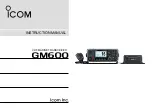
Chapter 3 SMART7 Operation
SMART7 Installation and Operation User Manual v6
36
Communicating using a Computer
A computer can emulate a remote terminal as well as provide the added flexibility of supporting multiple com-
mand batch files and data logging storage files. Use any standard communications software package that emu-
lates a terminal to establish bidirectional communications with the receiver. Examples include NovAtel Connect
and PuTTY. All data is sent as raw 8-bit binary or ASCII characters.
Refer to
Communicating with the Receiver
on the next page for details.
3.1.3 Ethernet Communications
The SMART7-I and SMART7-SI are equipped with a 10-Base-T/100-Base-TX Ethernet port that supports IPv4
Internet layer, TCP/IP transport and telnet. Users can conduct remote debugging, accept MRTCA (modified
RTCA) data and update firmware. OEM7 receivers are also equipped with NTRIP Version 2.0 (Networked Trans-
port of RTCM via Internet Protocol) client and server capability.
The Ethernet port must be configured before using. Refer to
on page 91 for configuration
details.
The Ethernet ports are Safety Extra-Low Voltage (SELV) circuits only and are suitable for connection
within a building only. Do not connect them to Telephone Network Voltage (TNV) circuits.
If intra-building connections are required, or the OEM7 receiver is installed in an outdoor enclosure, a
suitably rated Ethernet router or switch should be installed between the receiver Ethernet port and the
network connection.
Issue the
SAVEETHERNETDATA ETHA
command to ensure port settings are retained after a reset
and automatically used at boot time. The
SAVEETHERNETDATA ETHA
command is not applicable
to the
ICOMCONFIG
and
NTRIPCONFIG
command settings. The
SAVEETHERNETDATA ETHA
command takes precedence over the
SAVECONFIG
command configuration.
3.1.4 ICOM Communications
ICOM ports are virtual ports used for Ethernet or Wi-Fi connections. The transport/application layer of the ICOM
ports can be configured to use Transmission Control Protocol (TCP) for internet IP or User Datagram Protocol
(UDP) a slower and less reliable IP protocol.
Refer to
DNSCONFIG
command for Ethernet DNS configuration. If using DHCP, DNS is automatically set.
The following are the default ICOM configurations:
l
ICOMCONFIG ICOM1 TCP :3001
l
ICOMCONFIG ICOM2 TCP :3002
l
ICOMCONFIG ICOM3 TCP :3003
l
ICOMCONFIG ICOM4 TCP :3004
l
ICOMCONFIG ICOM5 TCP :3005
l
ICOMCONFIG ICOM6 TCP :3006
l
ICOMCONFIG ICOM7 TCP :3007
Each ICOM port can act as a server (waiting for an external connection to be made) or as a client (actively estab-
lishing a connection to a specific port).
















































